Original title: "Market plunges, Bitcoin drops to $80,000 again, is the bear market coming?"
Original author: Luke, Mars Finance
introduction
The cryptocurrency market is in turmoil. Yesterday, March 9, Bitcoin, the bellwether of the crypto world, plunged 7%, and its price fell from its high, causing widespread panic in the market. According to data from The Block, the spot market turnover of centralized exchanges (CEX) reached $1.77 trillion in February, which was a new low for the year, but it was 23.7% lower than the $2.32 trillion in January, indicating a significant decline in market activity. At the same time, crypto analyst Miles Deutscher pointed out on social media that only 12 of the top 100 crypto tokens by market value achieved positive returns in the past 90 days. For example, BERA soared 579.63%, TRUMP rose 85.61%, while Bitcoin fell 13.47%, and LINK plummeted 40%. This drastic differentiation and the decline in trading volume together outline a picture of extreme panic in the market. So, does this mean that the bear market has quietly arrived?
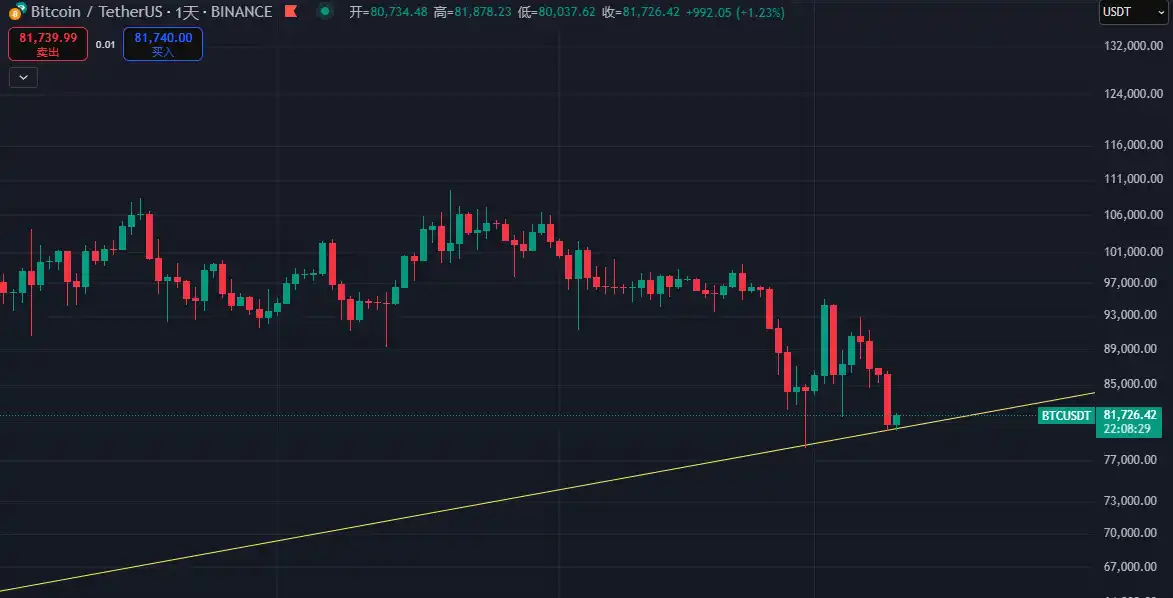
Market Sentiment and Fear Index
Market sentiment is one of the important indicators for judging trends, and liquidation data, as a direct reflection of market sentiment, provides a key supplement to this analysis. At present, the Fear & Greed Index of Cryptocurrency has fallen to 35, which is in the "fear" range, a sharp drop from 70 ("extreme greed") a month ago. This index combines factors such as volatility (25%), market trading volume (25%), social media sentiment (15%), questionnaires (15%), Bitcoin dominance (10%) and trends (10%), clearly reflecting the rapid deterioration of investor confidence. Glassnode's net unrealized profit/loss (NUPL) indicator further confirms this trend, falling from 0.6 (high greed) to 0.2, close to the level of the early stage of the historical bear market. Usually, when it is below 0, it marks the market entering the capitulation stage. The current value shows that although the market has not completely collapsed, panic sentiment has approached the critical point.
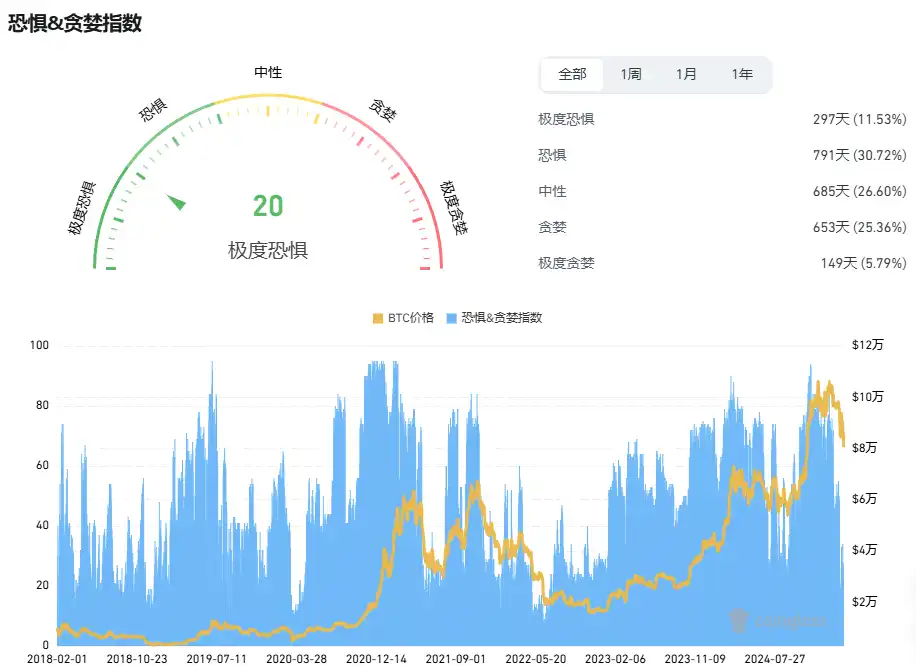
CryptoQuant data shows that demand growth in the Bitcoin spot market is slowing down, and the proportion of short positions in the open interest of the futures market has increased significantly. As of March 9, CME Bitcoin futures short positions accounted for 45% of total positions, up 15 percentage points from 30% in early February. This short-dominated trend has exacerbated market panic, and investors' expectations for price declines have increased. Some people even discussed whether Bitcoin will fall below the psychological barrier of $60,000.
The liquidation data further reveals the market dynamics. In the past hour, the liquidation amount of BTC reached 4.7072 million US dollars, and that of ETH was 1.3061 million US dollars, with a total of 11.5482 million US dollars. Among them, long positions were liquidated at 8.2925 million US dollars and short positions were liquidated at 24.3301 million US dollars. The short liquidation far exceeded the long positions, which may trigger a "short squeeze" and lead to a short-term rebound; in the past 24 hours, the total liquidation amount reached 616 million US dollars, with long positions liquidated at 540 million US dollars and short positions liquidated at 76.3075 million US dollars. The dominance of long liquidations reflects the continuation of bear market pressure, which is consistent with the deterioration of NUPL and the increase in short positions. Short-term volatility coexists with long-term risks. Investors need to be alert to complexity, pay attention to short squeeze opportunities while guarding against bear market downside risks.
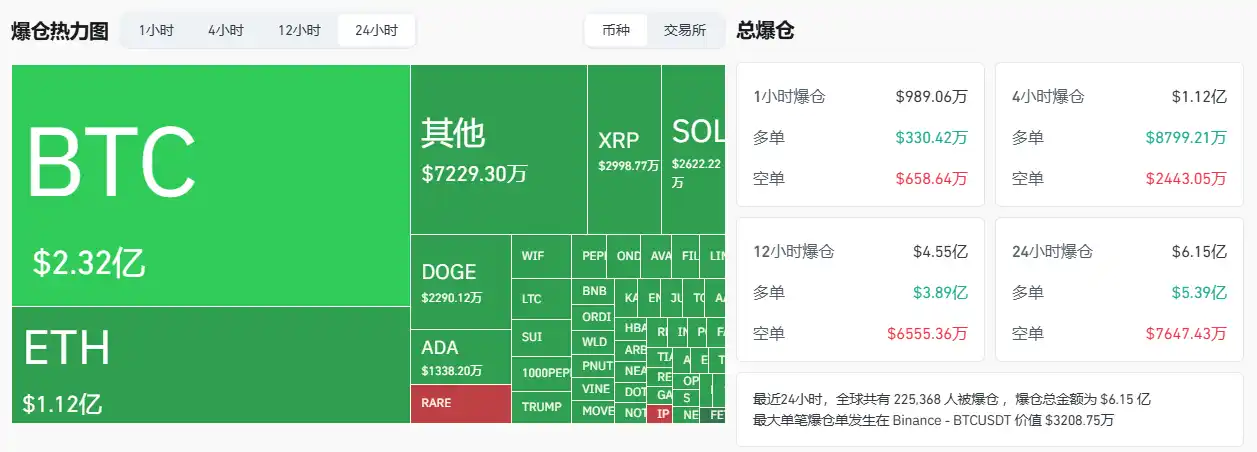
Technical analysis: key support and resistance
From a technical perspective, Bitcoin prices are at a critical juncture. After the high-level shock from November 20, 2024 to February 24, 2025 ended, the price formed a potential double top pattern, a typical bearish signal. After the double top neckline was broken, the price fell from the highest point of $82,000 to around $76,000. The volatility is close to the expected target (about 10%), but it has not been fully digested in terms of time.
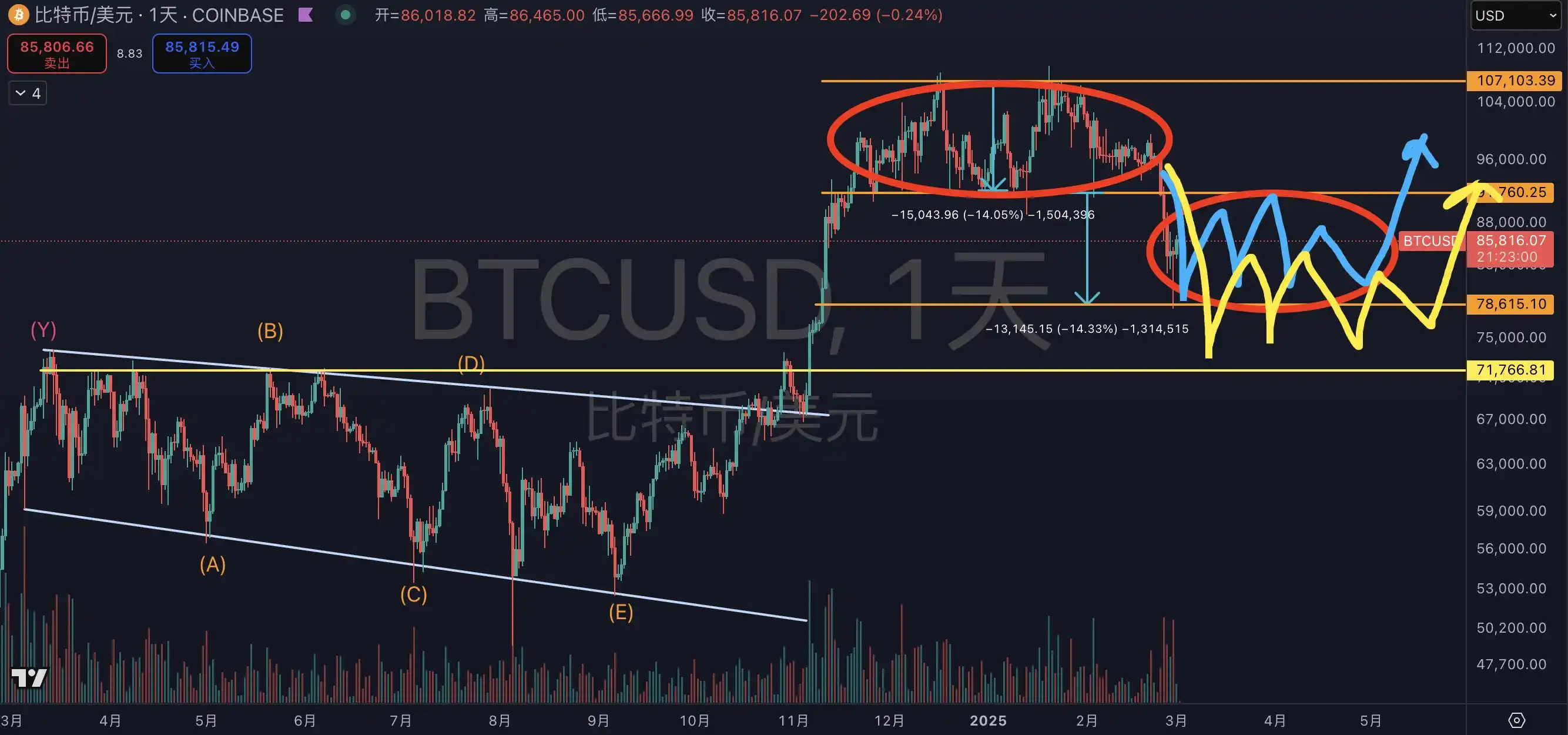
Analysts generally believe that the market may face two paths:
Path 1: Time for space If $78,000 becomes the bottom, both long and short sides need to wait patiently for two or three months to confirm the trend. Currently, the range between the 50-day moving average (about $77,500) and the 200-day moving average (about $72,000) has become the focus of short-term game. If the price can hold $78,000, it may form a W-bottom pattern, laying the foundation for a subsequent rebound.
Path 2: Further decline If the short-selling force prevails, the price may fall to the left trading concentration area of $70,000-$72,000. This area is not only the support level of the 200-day moving average, but also an important retracement level after the rebound from the low in August 2024. Trader Eugene Ng Ah Sio said in the Telegram group: "I am not in a hurry to participate in the bidding transaction at the current price. $75,000 is the only level I am interested in." This cautious attitude reflects the uncertainty of the market.
In addition, the relative strength index (RSI) is currently 42, which has fallen from the overbought zone (above 70) to a neutral to low level, suggesting that short-term selling pressure has eased, but has not yet entered the oversold zone (below 30). Technical analysis suggests that investors remain on the sidelines, avoid blindly chasing highs or bottom-fishing, and wait for the trend to become clear.
Macroeconomic background: Favorable conditions have been exhausted and uncertainty remains
The impact of macroeconomic factors on the cryptocurrency market cannot be ignored. First, changes in the global interest rate environment are putting pressure on high-risk assets. The yield on the 10-year U.S. Treasury bond recently rose to 4.2%, up 40 basis points from 3.8% at the beginning of the year, attracting funds to flow back from the crypto market to traditional safe-haven assets. At the same time, inflation expectations remain high and the Federal Reserve may delay rate cuts, which further weakens the appeal of Bitcoin as "digital gold."
At the legislative level, the weakening of good news has also exacerbated market pressure. Take Utah's Bitcoin bill as an example. The bill was passed by the state senate on March 7 with 19 votes in favor and 7 votes against, and is about to be signed into law by the governor. However, its core clause - allowing Utah to hold Bitcoin as a reserve asset - was deleted in the final review. The original clause would authorize the state treasurer to invest in Bitcoin, with a cap of 5% of its market value (about $25 billion), which would have made Utah the first state in the United States to have Bitcoin reserves. Today, the bill only retains basic rights such as custody protection and Bitcoin mining and node operation, and its influence has been greatly reduced.
The exhaustion of macro-favorable factors has dampened market confidence, while external uncertainties (such as the potential adjustment of the Trump administration's crypto policy) are also adding variables to the market. Bloomberg analysts predict that if Trump is re-elected, his tax cuts and deregulation policies may boost the crypto market in the short term, but the long-term effects remain to be seen.
ETF outflows: Institutional enthusiasm wanes
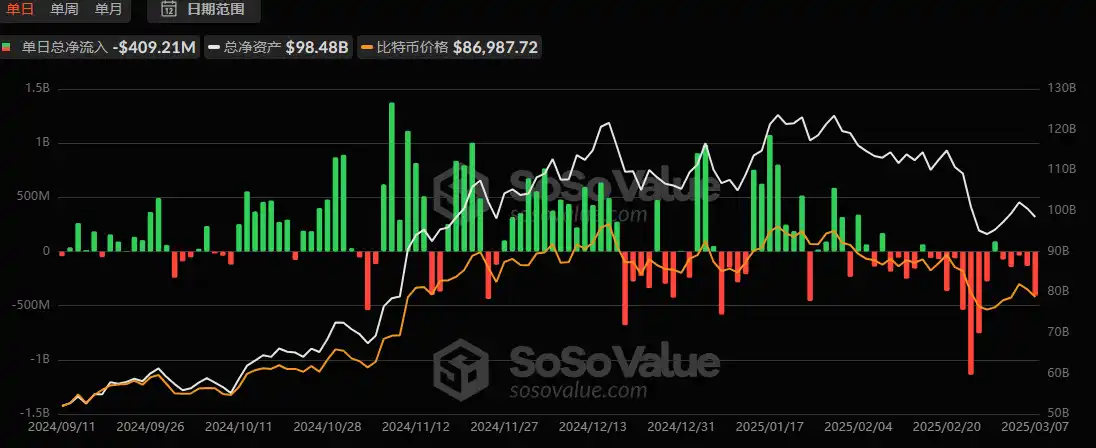
Institutional demand was an important driver of Bitcoin's price increase in 2024, but the recent outflow of funds from spot ETFs is worrying. According to sosovalue data, since March, the net outflow of US Bitcoin spot ETFs has exceeded US$500 million, among which Grayscale's GBTC outflow is particularly significant. Julio Moreno, head of research at CryptoQuant, pointed out: "Bitcoin spot demand growth is shrinking, and short positions in the futures market are dominant, which directly leads to price declines."
Jacob King, founder of WhaleWire, said bluntly: "The Bitcoin bear market has arrived. ETF outflows are at a record high, the institutional demand narrative has collapsed, and Bitcoin is heading for multi-year lows." Although this view is more extreme, ETF outflows do reflect the decline in institutional enthusiasm. In early 2024, the average daily net inflow of ETFs was as high as US$200 million, but now it has turned into a net outflow, indicating that institutional investors are re-evaluating the risk-return ratio of crypto assets. This change has further hit market confidence.
On-chain data: hope and uncertainty
On-chain data provides a glimmer of hope for the market. According to Glassnode's analysis, the behavior of long-term holders (investors who hold positions for more than a year) is shifting from a distribution phase to an accumulation phase. As of March 9, the Net Position Change of long-term holders turned positive, with an average daily inflow of about 5,000 bitcoins. Historically, this trend shift has often been a reliable signal of a market shift from a top to a bottom, such as the bottom formation period in early 2019 and March 2020.
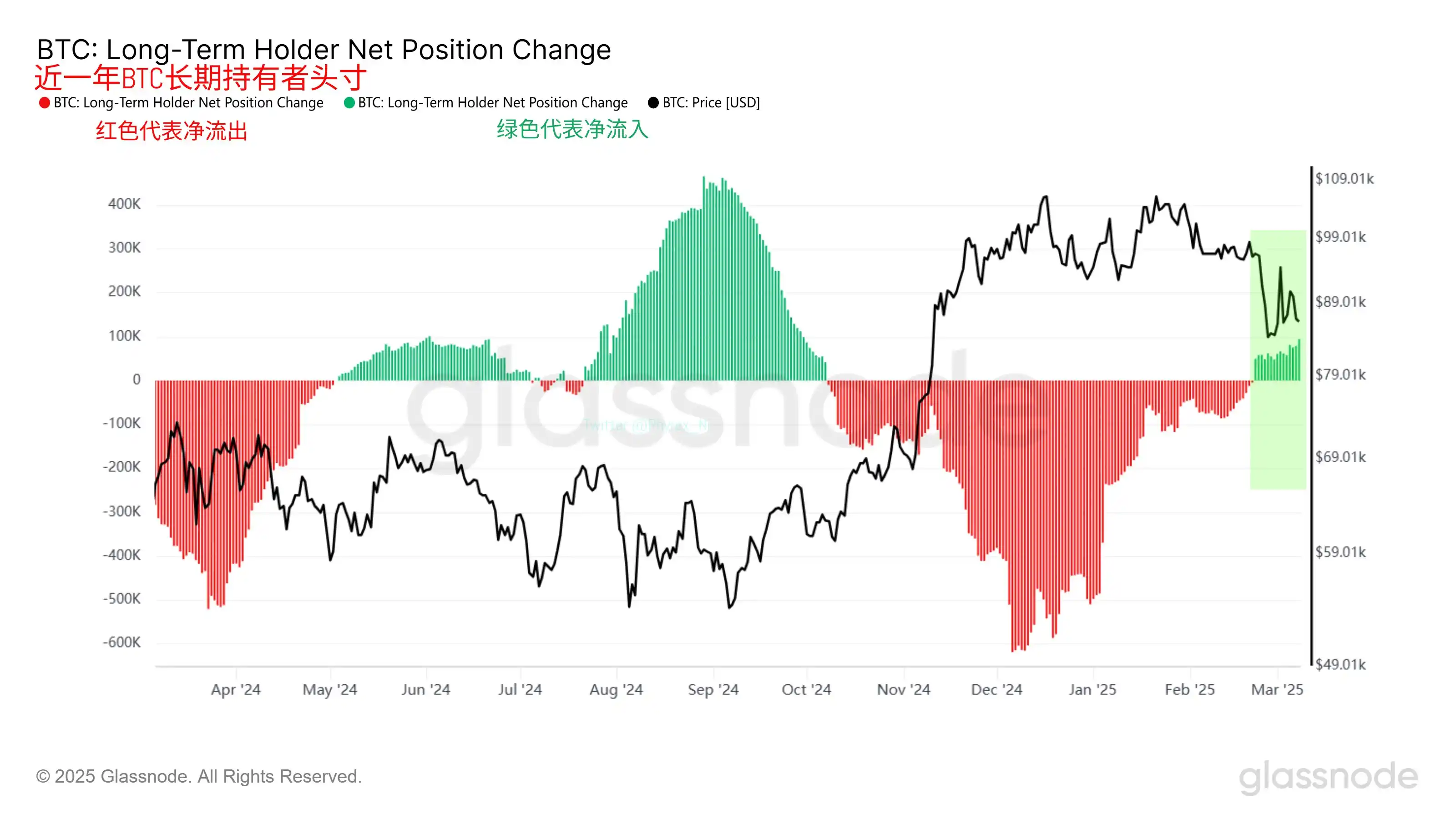
However, the current situation is different from previous cycles. First, the price decline may be slow and continuous, and the relative bottom may only be reached when long-term holders reach a new high (for example, more than 700,000 coins). Second, the rise of spot ETFs has changed the holder structure. Arkham Intelligence data shows that ETF holders currently control about 4% of the circulating supply of Bitcoin (about 840,000 coins), while the proportion of long-term holders on the traditional chain has dropped from 65% in 2023 to 60%. This may weaken the predictive power of traditional on-chain indicators.
Although it is encouraging that long-term holders have turned to buying mode, it is still in the early stages of inflows and the possibility of a reversal has not been ruled out. The market bottom forecast still needs to be verified in combination with more external signals.
Historical comparison: similarities and differences between bear markets
Looking back at history, the current market has similarities with the bear markets of 2018 and 2022, but there are also significant differences. In 2018, Bitcoin fell from $20,000 to $3,200, a drop of more than 80%, accompanied by the bursting of the ICO bubble and shrinking trading volume; in 2022, it fell from $69,000 to $16,000, a drop of about 76%, affected by the collapse of FTX and interest rate hikes. At present, Bitcoin has fallen by about 7%-13% from its high of $82,000, which is far from the historical bear market level.
The similarities are the decline in trading volume and market differentiation. For example, CEX turnover fell 70% from its peak in 2018, but is currently down only 23.7%. The difference is the emergence of institutional participation and ETFs, which provide a new buffer mechanism for the market. Therefore, the current panic may be a period of adjustment rather than a full-blown bear market, but if ETF outflows continue to expand, historical tragedies may repeat themselves.
Whether the market has entered a bear market is still unclear. The technical side shows that the risk of a correction still exists, and key support levels such as $78,000 and $75,000 are being tested; at the macro level, positive factors are limited, ETF outflows are intensifying, and institutional narratives are weakening; although on-chain data suggests that long-term holders have regained confidence, the bottom is not yet clear. The current panic may be a precursor to a deeper adjustment, or it may be the darkness before dawn.
For investors, caution is the best. As Miles Deutscher said, "This is a rotational market, and holders are being punished." Instead of chasing short-term fluctuations, it is better to focus on the intersection of technical support, macro dynamics and on-chain signals. Drawing on the wisdom of Warren Buffett - "Be greedy when others are fearful, and be fearful when others are greedy" - in the turbulent waves of the crypto market, risk management and long-term perspective are the way to survive.













